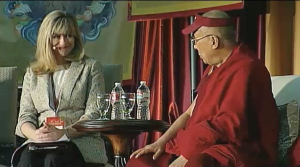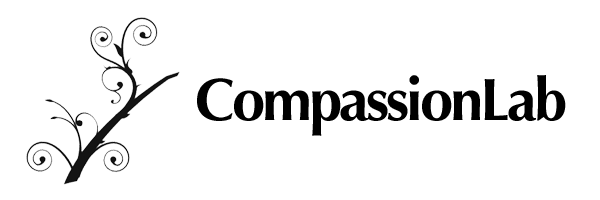CompassionLab in Dialogue with His Holiness the Dalai Lama
Posted by admin on Feb 27, 2014 in Uncategorized | 0 comments CompassionLab’s Monica Worline presented a summary of CompassionLab research to His Holiness the Dalai Lama in a dialogue devoted to the topic of compassion and ethics in business, hosted by Santa Clara University and Stanford’s Center for Compassion and Altruism Research and Education on February 24, 2014.
CompassionLab’s Monica Worline presented a summary of CompassionLab research to His Holiness the Dalai Lama in a dialogue devoted to the topic of compassion and ethics in business, hosted by Santa Clara University and Stanford’s Center for Compassion and Altruism Research and Education on February 24, 2014.
In his remarks, His Holiness commented that it is part of the human project to advance the idea of compassion beyond simply a felt concern. Compassion is often defined as an affective state that connects us to the well-being of others. In the dialogue, His Holiness pointed to research that shows that animals respond to the well-being of others in their groups, showing that an orientation toward others’ well-being is fundamental to the evolved biology of social life. And yet, the expression of compassion in action—especially for others who are far removed from our kin groups or tribes—is something that human beings must nurture by working together.
Understanding compassion in organizations as a collective accomplishment is where CompassionLab’s fifteen years of research adds a unique dimension to the ongoing work of many scientists who are researching the ways that compassion shapes our brains, minds, and hearts. CompassionLab has defined compassion in organizations as a four-part collective accomplishment that involves 1) noticing suffering; 2) making sense of the situation in way that 3) prompts feelings of empathy rather than aversion or indifference, and 4) acting to alleviate suffering. We look for ways that the basic individual impulse toward compassion is amplified or inhibited by organizational structures and processes into compassion organizing .
Here are three of the organizational factors that can amplify compassion as a collective accomplishment, as Monica described them in dialogue with His Holiness:
- Amplifier 1: Networks that spread the call for compassion broadly
In order for the suffering of members to become vivid in an organization, it has to take on a social reality. Networks—clusters of people who share a common interest within the organization—help suffering take on social reality and amplify calls for compassion. For example, in the case of a fire that destroyed the homes of some organization members, we found that the physical presence of someone in distress helped mobilize many networks within the organization, and that as calls for assistance went out to multiple networks, more resources were unleashed to help alleviate suffering. - Amplifier 2: Leadership modeling and messages
Messages and modeling from leaders can amplify the feeling of compassion and help it take on collective significance. In the case of the fire, the leader of the organization interrupted a large public event to draw attention to the need for compassion and to reinforce the value of coming together as a community to help. He also gave a donation on the spot to someone in the audience who was collecting money, modeling action to pave the way for others. - Amplifier 3: Routines that support regularized and coordinated action
While we may not think of routines as related compassion, this aspect of organizations is perhaps the most under-appreciated amplifier of compassionate action. Routines are repeated, recognizable ways that people work together to get things done. When routines can be put in the service of compassion, they help people more easily know what to do. For instance in the case of the fire, the organization had strong routines for global citizenship and volunteering, so members had established, practiced ways of coordinating to help others in need. The organization also had communication routines that made it legitimate and easy to use formal communication channels to notify others about harm, speeding up coordination. And finally, selection routines that emphasize fit with the organization and employee support routines that free up resources when people are in need have been demonstrated to help amplify compassion.
Though we would like to think that because we share a basic human impulse toward compassion, we would all respond this way, CompassionLab research demonstrates that compassion as a collective accomplishment can’t be taken for granted. In contrast with the example above, we experienced a different organization in the same industry with many of the same organizational features where one member lost everything in a fire, but we found no coordinated expression of compassion in action.
In her dialogue with His Holiness, Monica described three inhibitors that block individual feelings of compassion from becoming organized into action:
- Inhibitor 1: The difficulty of noticing distress in organizations
In this second case of an organization member who lost her home in a fire, concerns about professional reputation prevented the individual from seeking support at work. Many in the organization never knew about the fire, and even close colleagues did not know about it for weeks after it happened, inhibiting their ability to respond. Our work has shown that it is far more difficult to perceive suffering in organizations than we might assume. Reputational concerns and emotional display rules that limit us from expressing loss or sorrow also stop us from responding to suffering. - Inhibitor 2: Concerns about equity and rigid policies that limit discretion
Even in organizations that value compassion, we find that a significant inhibitor to the collective accomplishment of compassion is a concern from leaders or managers that they will be seen as “weak,” or that if they express compassion to one member of the organization others will take advantage of them later. In the case of the fire, the organization had a full-service hotel used to house executives. The director of the hospitality unit refused to grant temporary housing to those affected by the fire, because the policy of the organization stated that the housing was to be used for executives only. The leader of the unit was worried that this exception would open the door to many other requests. This example demonstrates that even for people who feel empathy and concern—as this unit director did—organizational policies that limit discretion, coupled with concern about being taken advantage of in the future, can limit compassionate action. - Inhibitor 3: Lack of shared values about the importance of common humanity
A third inhibitor lurks in a lack of shared value on the importance of common humanity. In the case of the fire where no compassion organizing occurred, some colleagues expressed the belief that it would hinder their work if they were expected to be kind or respond to colleagues in need. When the fact of the shared fate of people in the organization doesn’t translate into a shared value for taking care of one another, we are often left feeling helpless in organizing others to respond to pain.
The presence of these types of inhibitors in our organizations demonstrates that compassion organizing is not a given, nor is it a coincidence. Rather, it is skilled action that involves fundamentals of organizations such as networks, values, routines, and leadership. The more that we can discover the amplifiers to compassion, and remove the inhibitors, the more that we will realize the capacity we all have to enter the heart of suffering together and emerge collectively showing our glorious hearts of compassion.
To read more about networks, routines, and values as the social architecture of compassion: Dutton, Worline, Frost, & Lilius. Administrative Science Quarterly, 51 (2006): 59–96

